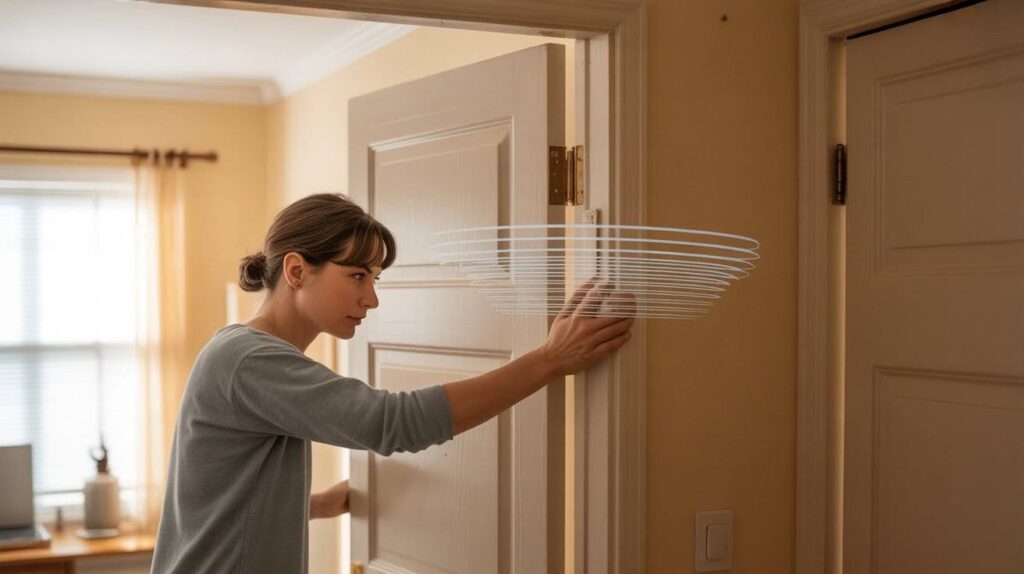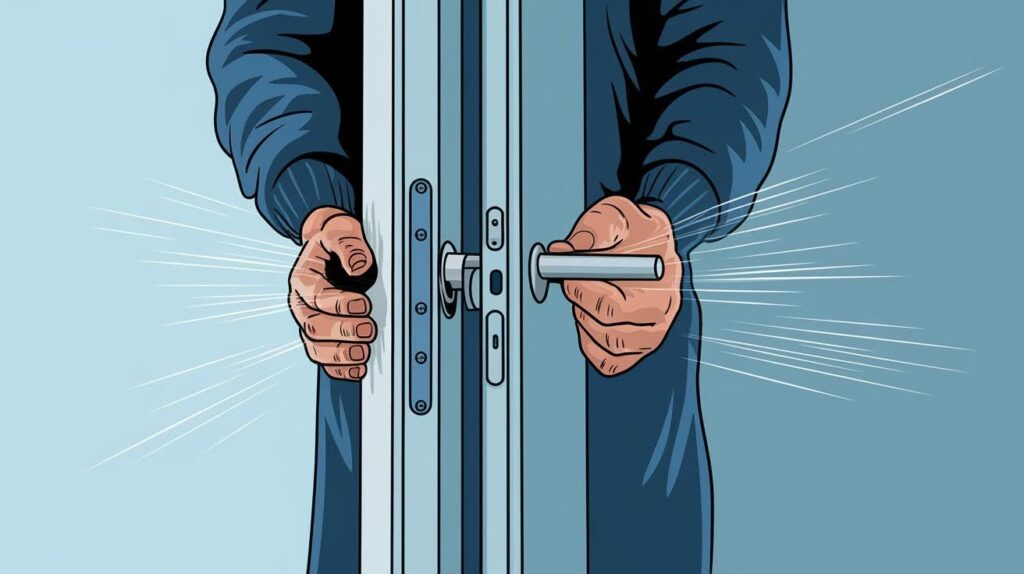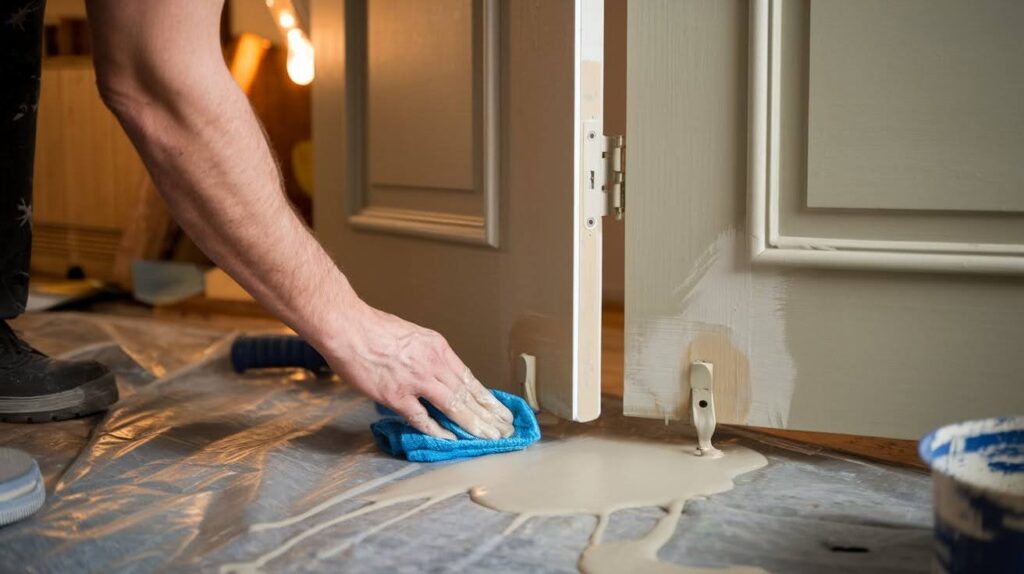That squeaky door is driving you insane. Believe me, I understand that feeling. That horrible creak of your squeaky door bolts through your home every time the door opens.
Here is the good part, I will show you a squeaky door hinge fix that will actually work. I have done this dozens of times, and so can you. No special skill required. No expensive repairs.
You will learn all about why hinges squeak, which supplies work best, exactly what you need to do to make your hinge silent, and how to fix a really stubborn squeak.
I will also walk through ways to avoid the squeak in the future.
You can do this. Let’s go ahead and make your doors quiet again.
Understanding Door Hinge Problems

Squeaky hinges are one of the most common household annoyances.
The good news? They’re also one of the easiest to fix. Most squeaks happen because metal parts rub together without proper lubrication.
Dirt, age, and moisture make the problem worse over time. Before you grab any tools, it helps to know what’s actually causing that irritating noise.
This knowledge ensures you pick the right fix the first time and avoid wasting effort on solutions that won’t work for your specific situation.
Why Door Hinges Become Squeaky

Understanding what causes hinge noise helps you fix the problem correctly and prevent it from returning quickly.
Metal rubbing against metal creates that awful squeaking sound. The hinge pin moving inside the knuckle builds up friction. Dust and dirt get trapped inside over time, acting like sandpaper between moving parts.
Old lubricant dries out and stops protecting the metal. Humidity causes minor corrosion that increases friction.
Listen for squeaking when you open or close the door slowly. The sound gets louder as the problem worsens.
Check if the door feels stiff or resistant. Look for rust spots or dark stains showing moisture damage or old lubricant buildup.
Sometimes squeaking means the hinge is loose. Wiggle the door gently to check for movement. A door that sags or doesn’t close properly needs more than just oil. Constant squeaking after multiple fixes suggests worn-out hinges with damaged metal parts.
Listen for grinding sounds instead of squeaking, which often means the hinge pin is bent or the knuckles are misaligned.
Tools and Materials You’ll Need

Gather these basic supplies before starting to make the job easier and get better results for your squeaky hinges.
- Lubricants: WD-40 works great for quick fixes and penetrates tight spaces. Silicone spray lasts longer and doesn’t attract dust. Lithium grease gives the longest protection for outdoor doors or heavily used hinges. White lithium grease also comes in spray form for easier application.
- Optional tools: A hammer and nail help remove stuck hinge pins by tapping gently from the bottom up. Old rags or paper towels catch drips and clean excess lubricant. A screwdriver might be needed for loose screws. Wire brush cleans heavy rust and grime before applying fresh lubricant.
- Safety and preparation: Put down cardboard or old towels to protect your floor since lubricants can stain. Open windows for ventilation when using sprays. Wear gloves if you have sensitive skin. Work during daylight if possible for better visibility.
Squeaky Door Hinge Fix: Step-by-Step Guide
Follow these six simple steps to stop squeaky hinges quickly and get lasting results without hiring a professional.
Step 1: Identify where the squeak is coming from

Open and close the door slowly several times and listen carefully for the exact location.
Most squeaks come from the middle or top hinge, so mark the noisy one with tape or remember which it is.
Step 2: Protect the floor and surrounding area

Lay down old towels or cardboard under the door since lubricant will drip down.
Move any rugs or furniture away and keep cleaning supplies nearby.
Step 3: Clean the hinge to remove dirt and old residue

Wipe the hinge with a dry cloth first, then use a damp cloth for sticky buildup.
Get into the crevices with a cotton swab and let the hinge dry completely before adding new lubricant.
Step 4: Apply lubricant properly

Spray or apply lubricant at the top of the hinge pin using short bursts, not continuous spraying.
Target the area where the pin enters each knuckle and apply product to all problem hinges at once.
Step 5: Open and close the door to work the lubricant in

Swing the door slowly back and forth ten times to spread the lubricant through all moving parts.
You’ll hear the squeak get quieter with each swing, and some hinges may need a second application.
Step 6: Wipe away excess and test for remaining noise

Clean drips from the hinge with a rag since excess lubricant attracts dirt.
Test the door normally for a few minutes and check back after an hour.
Advanced Fixes for Stubborn Squeaky Hinges
When basic lubrication doesn’t solve the problem, these deeper techniques address worn parts and serious buildup issues effectively.
- Removing the hinge pin and deep-cleaning: Place a nail or punch at the bottom of the hinge pin and tap gently with a hammer. The pin should slide up and out.
Clean the pin with steel wool or a wire brush to remove all rust and old grease. Clean inside the hinge knuckles using a cloth wrapped around a screwdriver.
- Using grease instead of spray: Apply lithium grease directly to the pin before reinserting it. Coat it completely and put a dab at the top of the hinge too. Grease lasts much longer than spray lubricants.
You won’t need to reapply for a year or more. Wipe off extra grease immediately since it’s thick and messy.
- Fixing hinges that squeak again after lubrication: Check if the pin is worn smooth. A shiny, polished pin has lost its protective coating. Look for gaps between the door and frame since misalignment causes constant friction.
Tighten all screws on the hinge plates and consider the door’s weight. Heavy doors wear out hinges faster.
- Replacing damaged or worn-out hinges: Buy hinges that match your current size exactly. Take one to the hardware store as a sample. Remove one hinge at a time to keep the door supported.
Fill stripped screw holes with wood filler and let it dry before drilling new pilot holes. Install the new hinge using all screws.
When Lubricant Doesn’t Work
Sometimes squeaking signals problems beyond dry hinges that require different solutions to fix the underlying structural issues properly.
Check if the door sits evenly in the frame with consistent gaps all around. A door that binds at the top or bottom puts stress on hinges.
Wiggle each hinge to check for movement. Tight hinges don’t budge at all.
Pull the pin out and roll it on a flat surface. Bent pins won’t roll smoothly.
Feel the door and frame for dampness. Bathroom and exterior doors face this problem most.
Look for paint bubbling or peeling near hinges. Wood swells when wet and puts pressure on hinges. Fix the moisture source first, then address the hinge problems after everything dries out.
Preventing Future Door Hinge Squeaks
Regular care keeps hinges quiet and working smoothly for years while avoiding the frustration of recurring noise problems.
How often to lubricate your hinges:
- Indoor doors need lubrication once or twice a year
- Outdoor doors require attention every three to four months due to weather exposure
- High-traffic doors like kids’ rooms and bathrooms benefit from quarterly maintenance
- Listen to your doors and don’t wait for scheduled maintenance if they start squeaking
Best long-term lubricants:
- Lithium grease outlasts all spray products and lasts for a year
- Silicone spray works well for regular maintenance without getting sticky or attracting dirt
- Avoid vegetable oil or soap as these cause buildup problems later
- Dry lubricants like graphite powder work but make a mess
Proper cleaning and hinge care:
- Dust your hinges when you clean the house to prevent buildup
- Address squeaks immediately when you notice them before they become bigger problems
- Check hinge screws during regular maintenance and tighten any that have worked loose
- Keep doors from slamming as the impact damages hinges and speeds up wear
Conclusion
I remember the first time I tried to fix a squeaky door hinge in my college apartment. The terrible sound of the door creak lasted less than five minutes, and I thought I was a home repair expert. You can have a similar fix.
Consider starting simple with the spray method. Most squeaks you hear can be eliminated quickly by using this method without complex techniques. If this did not work, use the options I talked about.
You have one quick fix away from a quiet home. Have some lubricant and try it on a door latch or door hinge today.
Have questions, want to tell me the results? Leave a comment below. I would like to know what happened.
Frequently Asked Questions
What’s the best lubricant for squeaky door hinges?
Silicone spray and lithium grease work best for most situations. WD-40 offers a quick fix but doesn’t last as long as the other options.
How long does door hinge lubrication last?
Indoor hinges stay quiet for 6-12 months after proper lubrication. Outdoor or frequently used doors may need treatment every 3-4 months depending on conditions.
Can I use cooking oil on squeaky hinges?
Don’t use cooking oil or vegetable oil on hinges. These oils get sticky over time and attract dirt, making the problem worse instead of better.
Why does my door still squeak after lubrication?
The hinge might be damaged, loose, or misaligned. Check for bent pins, loose screws, or gaps in the door frame that cause friction beyond what lubricant can fix.
Do I need to remove the hinge pin to stop squeaking?
Most squeaks can be fixed without removing the pin. Just apply lubricant at the top of the hinge and work the door. Remove the pin only for stubborn problems or deep cleaning.

